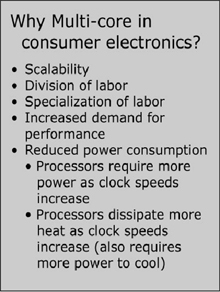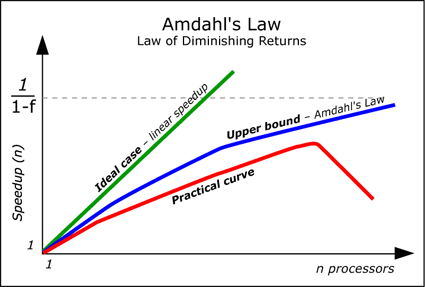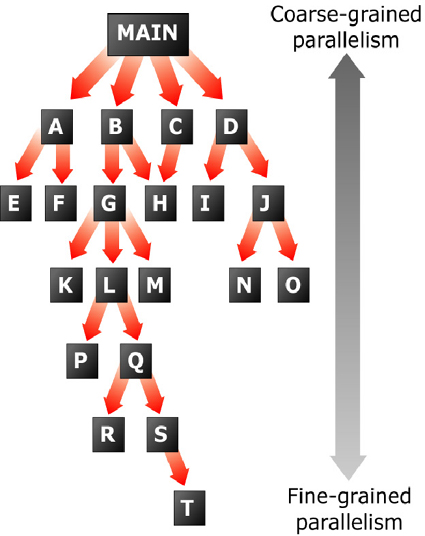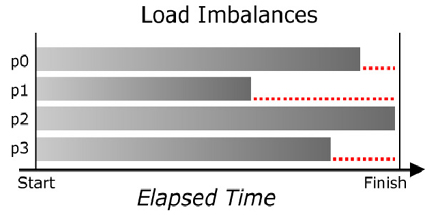

 |
Putting multicore
processing in context: Part One
Today’s embedded devices are increasingly based on multi-core designs.
Systems-on-a-chip (SoCs) often contain two or more processor cores in
homogeneous or heterogeneous combinations, and FPGA-based designs can include a
virtually unlimited number and variety of cores. An asymmetric multiprocessing
(AMP)-based RTOS is one approach to utilizing multi-core processors; symmetric
multiprocessing (SMP) is another. But from a historical perspective, multiprocessor/multicore designs have been
around almost as long as the computer in general. I believe that Burroughs
introduced the first commercially available one back in 1962; many more have
followed. Most of them had very specific purposes in mind. Many of the early ones were used in data centers, and for scientific
applications. You can also make a case for them being in the early desktops of
the late 80s with the introduction of the math co-processor and device
controllers such as an Ethernet controller. The question is: why are embedded device manufacturers becoming so enamored
with multi-core devices now? One reason is that embedded devices have more and
more tasks being heaped on them. My first cell phone was a StarTek. It had a rudimentary LCD display and
frankly was not very useful for anything other than making a phone call. It had
a 24-hour standby time and maybe an hour talk time once the battery was broken
in. That was not a real problem though since my first plan was for 30 minutes a
month. But look at today’s phones and the demands made on them: built-in cameras,
video capabilities, nice graphical interfaces for browsing the Web, calendars
and all sorts of games. It is no wonder that designers are looking at ways to
get more performance, and better form factor while extending battery life. Why multicores? Adam Smith's
answer Smith suggested that a pin factory that had adopted such a "specialization of
labor" might produce tens of thousands of pins a day whereas a pin factory in
which each worker attempted to produce pins, from start to finish, would produce
very few pins. Heterogeneous multicore designs such as the OMAP processor, which employ both
a DSP and an ARM core, embody Adam Smith’s concepts of both division of labor
and a specialization of labor. This approach is a Since power consumption is both a function of voltage and frequency (power
consumption increases proportionally with frequency and power consumption
increases to the square of voltage increase, the division of labor aspect of
multiprocessing is of particular interest to manufacturers of portable devices.
Most portable electronic devices do not operate at peak capacity of their
processors all the time. However, to handle peak demand, manufacturers have to
provide a processor that can deliver the processing power to meet peak demands.
While the processor can be throttled down between periods of peak performance,
this may not be an option for devices that require operation in an intermediate
performance range. For most processors they must either run at full speed or be
in an idle state. This is where adding a number of slower processors may be appealing to device
manufacturers. If the issue of peak performance can be segmented so that
multiple processors can address peak performance needs, they can then be
throttled down or put to sleep during periods of inactivity. For periods where
performance demands are low, one or two of the low performance processors can
provide satisfactory processing power. The limits on your multicore design are essentially the same as the
constraints on classical multiprocessing systems: Amdahl’s law; serial code
execution; code execution granularity; load-imbalance; synchronization; and
cache coherency. Illustrated in Figure 1 above,
Amdahl’s Law states, “The non-parallel fraction of the code (i.e., overhead)
imposes the upper limit on the scalability of the code”. Thus, the maximum
parallel Speedup S(p) for a program that has a parallel fraction f: S(p) < 1/(1-f) The non-parallel (serial) fraction of the program includes the communication
and synchronization overhead. So according to Amdahl, if you have a program or a suite of tasks that is
comprised of say 50 percent serial code, no matter how many processors you add,
you will only get a performance increase of 200 percent. On the other hand, if
your code contains no serial code, like four tasks that have no communication
requirements, no shared resources, etc, then you can achieve a 1000 percent
speed up by going from one processor to 10. Serial code execution Spinlocks. One prime example
of how code becomes serialized is when there is the potential for processes
running on different processors to attempt to gain access to a resource that is
already in use by another process (Figure 2,
below). OS developers use what is called a Spinlock to act as a gatekeeper for a
resource. A Spinlock (sometimes called a Spinlock Mutex) is a special data
structure used in multiprocessing. It is similar to a Mutex or a semaphore in
that it protects access to resources that cannot be accessed by more than one
process at a time. The primary difference between a Spinlock and a Mutex is that
the Spinlock depends on a hardware ”test and set” mechanism that arbitrates
between two or more processes attempting access at the same time. When a process attempts to access a resource that is in use by another
process, the “blocked” process(s) will “spin” until the resource becomes
available; hence the name Spinlock. In essence, the processes queue up until
they can get access to the resource. There are different algorithms that can be
used to assign priority to processes waiting in a Spinlock. Regardless of the
algorithm used, once a process gets access to a resource, they keep it until
they decide to give it up. The granularity of Spinlocks and the resources that they are used to protect
has dramatic impact on the degree to which application code is serialized.
Devices such as hard drives and other IO devices come to mind when I think of
shared resources but, depending on the type of OS, kernel objects can also be
protected by Spinlocks. The granularity of a Spinlock is a function of the
number and type of resources that they are used to protect. A coarse-grained implementation of a Spinlock would be used to protect all IO
devices. So, for example, once a process gains access to any IO device, even a
process that needs access to an unused resource will spin in the Spinlock until
the lock is released. The other extreme would be to have a Spinlock protecting
each shared resource in the system. Each approach has its advantages. A coarse-grained approach is simple to
implement, but has the potential to serialize the application. The fine-grained
approach makes more resources available in parallel, but is more complicated and
has the potential to exhibit problems such as deadlock and other classical
problems associated with resource protection schemes used in single processor
systems. This problem can be overcome to a large degree through the use of
watchdog applications and other types of heuristics. However, it does add to the
overall overhead of the system, so it comes at a cost. One final note: Spinlocks don’t just protect system data or resources, they
can also be applied to application data. For example, if some device
configuration data consists of a string of bytes, it will need to be locked
during update to ensure data integrity. Granularity of Parallel Code
Execution Fine-grained architectures (Table 1,
above) have between two and a couple of dozen processors. An example of a
massively parallel problem approach would be if I want to add 2048 numbers
together and had 1024 processors to do it with. In the first iteration, all 1024
processors each add two numbers together. The second iteration of 512 processors
adds the 1024 numbers together and so on. It would only take 11 iterations to
add all 2048 numbers together in this fashion. Course-grained programming (Table 2, above
and Figure 3 below), on the other hand, approaches the problem at a level
we are all more familiar with; segmenting our programs at the task level. Legacy
code can be easily converted to run on multi-core architectures using the
course-grained approach. It is usually a good fit for engineering departments as teams are usually
tasked at the application level. A good understanding of how the overall system
works is necessary so that the different tasks are prioritized so that the
execution is ordered in a way that optimizes performance. The down side of
course-grained parallelism is that it may lead to load imbalance. There are advantages and disadvantages to both approaches. The fine-grained
approach brings massive amounts of processing power to bear on a problem. It
also has the potential to utilize the processors more equally in a load
balancing system. That being said, other than data plane applications there are
very few control plane applications in the embedded space that could be easily
implemented that would benefit from massive parallelism. Furthermore
fine-grained segmentation is almost impossible to do without the use of a
compiler that is explicitly designed to exploit massive parallelism. On the other hand, if one has a compiler that is designed to exploit
fine-grained parallelism, or you have hand written the code to exploit a large
number of processors, then it is easy for all the processors to be utilized
efficiently. Another disadvantage in exploiting fine-grained parallelism is that
there is a large overhead to pay in terms of synchronizing and communication
overhead. Synchronization Overhead In the sum of 2048 numbers example used above, delays incurred due to memory
latency, interrupt or other factors cause the execution times to vary between
the different processing elements. As a result of the different execution times,
tasks that are dependent on these intermediate results essentially stall until
the result is ready. As the parallelism of an application increases, the
potential for synchronism overhead also increases. In general, there is a point
for almost all problem domains where the addition of additional processing
elements will cause a slow down in performance. Load Imbalance As shown in Figure 4 below, if there are a discrete number of tasks that need
to be performed and the execution times are unequal, some cores will be idle
while others are still executing. Cache Coherency in uniprocessor
designs Main memory on the other hand typically takes two or more cycles to access.
When a main memory fetch occurs, the process stalls. This is avoided by keeping
anticipated or frequently used data and instructions in cache. The processor
will only stall when the information it needs is not in cache. One side effect of using this two-layer approach to memory access is that if
cache is written to, then cache and main memory no longer contain the same
information. When this occurs, cache and main memory are considered incoherent.
There are different approaches that can address this problem. The two most
common are “write through” and “write back.” The simplest cache coherency mechanism is “write through.” When writing to
cache using “write through” each time the cache is written to, it also writes
through to main memory. Thus coherency is maintained. The down side is that the
processor stalls while the write through completes. A more advanced implementation for maintaining cache coherency tries to
address stalling during a write by buffering up writes so that they occur less
frequently. When the buffered writes are written to memory, they are written in
“burst mode.” This technique is called “write back.” The write back implementation for obvious reasons is more complicated than
write through. The write back implementation requires that a list of “dirty”
cache lines be maintained. The dirty entries indicate cache lines whose contents
are not the same as in main memory. When the cache loads a cache line from main memory, its contents are marked
as clean. When the processor writes to a cache location, an entry is made to the
cache list to indicate that the cache entry is dirty. Later, depending on when
the “caching algorithm” decides, the dirty cache entries are written to main
memory. Both write through and write back schemes can be implemented either in
hardware or in software. All modern commercial microprocessors I am aware of use
hardware to enforce cache coherency. Multi-core Cache
Coherency Now, in addition to maintaining coherency between memory and a single cache,
the cache coherency scheme must address simultaneous reads and writes to an
individual processor’s cache while maintaining coherency with the shared memory
as well with all the other cache memories that are used by the other processors.
The only efficient mechanism for doing this is by using cache coherency
hardware. Regardless of the hardware assist method used to maintain cache
coherency, using cache in multi-core systems tends to serialize process
execution. The question is to what degree. In later articles, we will explore
how different hardware architectures address this. Todd Brian is product marketing manager at
Accelerated Technology, a
Mentor Graphics division. Part Two of this
series will cover various aspects of multiprocessing from an RTOS perspective,
looking at two different approaches - symmetric (SMP) and asymmetric (AMP)
multiprocessing - their benefits and limitations in real time, deterministic
environments. To learn more about this topic, go to More
about multicores, multiprocessing and tools Copyright 2005 © CMP Media LLC
By Todd Brian, Embedded.com
O=2 9 2006 (9:00 AM)
URL: http://www.embedded.com/showArticle.jhtml?articleID=175802474
One answer to my question may lie in economic theory,
specifically Adam Smith’s “Wealth of Nations.” It opens with a dramatic
recommendation that rather than each worker performing all tasks required for
pin making: rolling the wire, cutting the wire into pieces, sharpening the wire
and bobbing the end, each worker should specialize in performing a single task.
One worker would roll the wire; another would sharpen the wire, another bob the
ends and so on.  good one for
manufacturers of cell phones and other electronic devices, which perform a
multitude of roles: the DSP efficiently performs signal-processing activities
and the ARM core performs the role of a general-purpose processor. (Panel to right)
good one for
manufacturers of cell phones and other electronic devices, which perform a
multitude of roles: the DSP efficiently performs signal-processing activities
and the ARM core performs the role of a general-purpose processor. (Panel to right) 
What is
serial execution? Execution is considered serial when one or more cores in a
multi-core system are not executing code. This can occur due to a variety of
reasons. Sometimes it is because there is no reason for code to be executing on
multiple cores. Basically, the system is idle. From a performance perspective,
this is nothing to worry about. However, there are a number of situations where
it would be desirable for all of the processors to be executing code, but can’t
because of data or resource conflict, load-imbalance, synchronization or the
need to maintain cache coherency. 
There are two general types of coding approaches that you
can take with multicore devices: fine-grained parallelism (in the case of the
connection machine and others that have hundreds or thousands of processors –
this is called massively parallel) and coarse-grained parallelism.



In the
context of parallel execution, synchronization overhead is the waiting and
communicating incurred by interdependent tasks waiting for other tasks to
intermediate results in order to begin execution again. Unlike waiting for a
Spinlock to release because of resource contention, synchronization overhead is
caused when a task cannot continue execution until an intermediate result is
provided by another task.
Fine-grained
applications typically take advantage of doing the same activity many, many
times in parallel. The example above used a loop unrolling approach.
Course-grained segmentation approaches parallelism at the task level, because it
is almost impossible to design and segment code in such a way that each task has
the same execution time. The different execution times lead to what is called
“load imbalance.” 
Cache memory is used to speed execution of a microprocessor.
Cache memory is typically implemented as a relatively small amount of high-speed
memory. Unlike main memory, cache memory can satisfy memory reads and writes at
processor frequency.
Utilizing cache in a multi-core design takes the problem of
cache coherency to the next level. There are a number of multicore architectures
on the market now that utilize shared memory. These architectures also utilize
cache memory to speed execution.
